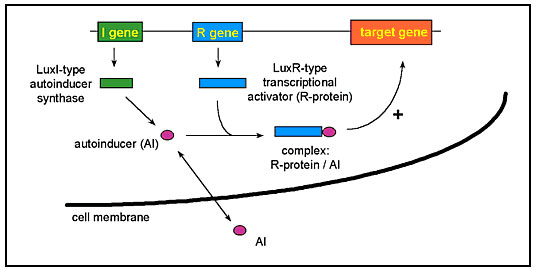Volume 4, Number 4—December 1998
Synopsis
Cell-to-Cell Signaling and Pseudomonas aeruginosa Infections
Figure 3

Figure 3. Cell-to-cell signaling systems. Cell-to-cell signaling systems are composed of two genes. The I gene encodes an autoinducer synthase and the R gene encodes a transcriptional activator protein (R-protein). The autoinducer synthase is responsible for the synthesis of an autoinducer molecule (AI), which crosses the cell membrane. With increasing cell-density the intracellular concentration of AI reaches a threshold level, and the AI then binds to the transcriptional activator. The complex R-protein/AI activates the expression of specific target genes.
Page created: December 16, 2010
Page updated: December 16, 2010
Page reviewed: December 16, 2010
The conclusions, findings, and opinions expressed by authors contributing to this journal do not necessarily reflect the official position of the U.S. Department of Health and Human Services, the Public Health Service, the Centers for Disease Control and Prevention, or the authors' affiliated institutions. Use of trade names is for identification only and does not imply endorsement by any of the groups named above.